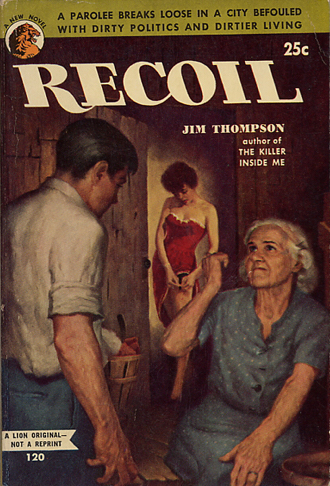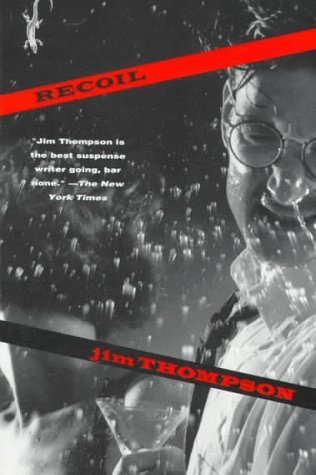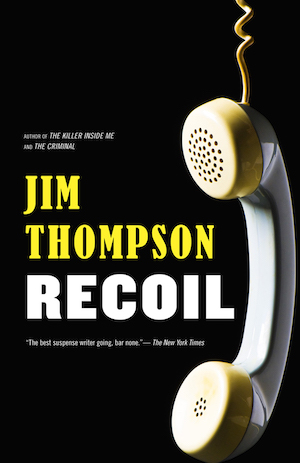Jim Thompson's Recoil: A Review Essay
Surfacing Events
Random House has retired Jim Thompson from its Black Lizard list, and along with the novels go those sharply designed covers by Keith Sheridan Associates, covers which will always—for me at least—represent the "look" of a Jim Thompson novel. Little Brown is stepping in, and reissuing the novels under its Mulholland Books imprint. The new book covers are boring, even though their on-the-cheap look is probably truer to Thompson's origins as a pulp fiction author for mass market publisher Lion Books. Or rather, the new covers represent a compromise between the racy covers produced by Lion Books, and the more reserved sensibility that characterizes much modern book design. The Keith Sheridan covers were neither (though a few very cleverly gave a nod to the tawdry tableaux of the Lion first editions), and I loved them. Yes, I'm guilty of judging books by their covers, especially when I'm selecting one for purchase, and I'm sorry to say that I very likely would never have read a Jim Thompson novel if I had first been exposed to them under either the Lion or the Mulholland covers.



The removal of Thompson from Random House's prestigious Black Lizard list is about more than just book covers, though; it's also about a diminution in status for Thompson as an author; one might even call it a market correction: the Jim Thompson bubble has finally burst. In some ways, this correction was necessary: after the Jim Thompson revival began in the late eighties, the claims made for him as a writer became increasingly extravagant. For example, the author of Thompson's American National Biography (New York: Oxford University Press, 2013) entry claims that Thompson wrote some of the most demanding books in the annals of crime fiction
(he didn't), and that he stretched crime fiction to its formal limits
(he remained well within the genre's formal limits). Overrated or not, Thompson was, in my opinion, an excellent novelist, and he's certainly one of my favorite crime novelists. For much of the past thirty years, however, the adulation of Thompson has been more about what literary critics wanted to see in his novels than about what is really there. He was celebrated for his New Deal socialist politics, and his novels were read as excoriating critiques of 1950s America, a decade that perhaps produced too few teachable works of American literary social criticism. As a bonus, Thompson's spare prose style left plenty of room for scholars to fill with critical theory, like a carpenter going to work on a drafty home with a can of polyurethane spray foam insulation. Maybe English teachers felt they had finally found their man in Jim Thompson.
If part of Thompson's critical appeal was his politics, than that would explain why one of his novels, Recoil (New York: Lion Books, 1953), which I consider to be among his finest, has received comparatively little attention. Because Recoil, while certainly critical of 1950s American capitalism, also thematizes the failure of big government social bureaucracies, making it a novel that fits less well with Thompson's image as a New Deal darling, à la Walker Evans or Woody Guthrie.
But that's all speculation. I do know that Recoil is one of my favorite crime novels, and beginning an essay about it with a brief history of Jim Thompson book covers is actually rather appropriate, because covers and surfaces are essential to an aesthetic that Thompson worked with in several novels, and which he perfected in Recoil: an aesthetic of flatness and superficiality.
Thompson populated Recoil almost exclusively with what English teachers taught us to call "flat characters", and Thompson managed to create from that stock of flat characters a novel both enjoyable and artistically compelling. Few writers work in this mode (at least not intentionally), and fewer still attempt it without falling back on the vice of allegory. But Thompson did. The Danish writer Isak Dinesen, one of Thompson's contemporaries, though not often (if ever before) coupled with Thompson, also preferred to work with flat characters, and she developed an aesthetic of superficiality, influenced no doubt by her interest in marionette theater and the commedia dell'arte. Although she elaborated this aesthetic over the course of her career, it probably achieved its best expression in her story collection Winter's Tales (New York: Random House, 1942), where she perfected a porcelain prose style, brittle as a baroque figurine. This is a book where surfaces that crack are deadly ("Peter and Rosa"). In the opening story, "The Young Man with the Carnation," the protagonist is himself an author; his first book having been a celebrated work of social realism, he finds himself struggling to complete a much anticipated follow-up. One night he goes to the harbor in Antwerp, and Dinesen writes that the ships
[H]ad a message for him, but at first he did not know what it was. Then he found the word; it was superficiality. The ships were superficial and kept to the surface. Therein lay their power; to ships the danger is to get to the bottom of things, to run aground. They were even hollow, and hollowness was the secret of their being; the great depths slaved for them as long as they remained hollow.
For Thompson as well, superficiality is about motion. In Recoil, his titanium clad, two-dimensional characters move with breakneck speed through the plot, all characters functioning like automata, helping the novel achieve blisteringly hot, maximum velocity. Recoil is an exciting novel, in part because the characters are flat enough that they can be made to do whatever the plot requires of them, without ponderous psychologizing to justify their actions.
Another midcentury writer, also not often coupled with Thompson, who detested literary psychologizing (especially of the pschyoanalytic kind) was Vladimir Nabokov, and he too had an aesthetic of surfaces. Nabokov's novels are famously draped in dense, often impenetrable, webs of intertextuality and parody. In the opening chapter of his late novel Transparent Things (New York: McGraw-Hill, 1972) he makes an uncharacteristically direct statement on the question:
When we concentrate on a material object, whatever its situation, the very act of attention may lead to our involuntarily sinking into the history of that object. Novices must learn to skim over matter if they want to stay at the exact level of the moment. Transparent things, through which the past shines!
And one of Nabokov's favorite writers, Edgar Allan Poe, had his famous detective of "The Murders in the Rue Morgue" (Philadelphia: William H. Graham, 1843) opine, "There is such a thing as being too profound. Truth is not always in a well. In fact, as regards the more important knowledge, I do believe that she is invariably superficial" . In the case of all four writers, we mustn't make the mistake of confusing flatness with simplicity. While the characters in Recoil are flat, the plot itself is not. Quite the opposite, in fact: a novel with flat characters needs narrative complexity. You could conceptualize such a novel as a mobile, with multiple planar objects constellated around a central point, such that the position and weight of each object are precisely calculated to maintain the balance of the whole. If the author wishes to generate motion in such a work—and if the work is a novel, then he better had—then this motion is powered by thematic torsion, which eventually exhausts itself as the plot unravels. The novel ends not so much with the resolution of a conflict, as with a repositioning of the various characters vis-à-vis one another, even if they are dead, and in a Jim Thompson novel, a dead character remains a character to be reckoned with.
Thompson's approach to plotting alters the traditional model of dramatic structure (Exposition — Rising Action — Climax — Falling Action — Dénouement). Thompson begins Recoil almost immediately with the Climax, Cosgrove's bureaucratic jailbreak, so that the novel depends for its success almost entirely on the reader's fascination with the movement of, and interaction between, the novel's multiple parts, its characters.
Does it succeed?
It does, in part because Thompson's prose style is flat, linear, and taut, like the lines of wire that hold together the mobile described above. Look at Thompson's flat prose style, and explore its narrative implications, by following Ezra Pound's advice in ABC of Reading (New York: New Directions, 1934): The proper method for studying poetry and good letters is the method of contemporary biologists, that is careful first-hand examination of the matter, and continual comparison of one slide or specimen with another.
Because this review essay is intended to be brief, I will spare you the continual comparison
, and content myself with two specimens in which one character describes another. First, from Recoil:
As I talked, I adjusted the wind-wing on the window next to me until I picked up Dr. Luther's reflection in its nickled frame. He seemed well pleased with my replies, although, due to three slightly protruding upper teeth, the mere relaxation of his features sometimes gives him the appearance of smiling.
That first, short, 24-word sentence contains nothing not essential, so that it forms an almost completely flat surface, a measure of which is how little punctuation it requires; and it would require none (save the concluding period) were the opening syntactical inversion of that subordinate clause not needed to coordinate the sentence with the dialogue that precedes it. The diction is concrete and simple. Despite this simplicity and spareness, Thompson gave the sentence, with a prescience that reminds me of Sinclair Lewis, just enough detail to evoke, for readers half a century later, a strong sense of setting—in this case, time period, an era when automobiles had wind-wings and when even wealthy men like Doc Luther didn't have air conditioned cars. This stylistic attenuation notwithstanding, the sentence conveys drama, mystery, foreboding: why does Cosgrove feel the need surreptitiously to observe Doc Luther?
The strip of nickled frame makes an apt symbol for Thompson's style: a surface on which Thompson reflected an image back to the reader, a reflective surface just wide enough to capture part of an image, but too thin reflect the whole, so that what the reader sees is partially a distortion: Cosgrove can probably see part of Doc's face in the nickled frame, and, as he moves the wind-wing, he eventually sees it all; never, however, can he see Doc's whole face from a single angle. That is, for me, the essence of Thompson's prose style: multiple, flat, angular surfaces on which to reflect the world of the novel back to the reader.
The second sentence is more interesting, remarkable actually, because as soon as Cosgrove attempts to interpret what he sees, the sentence begins to show signs of stress, first syntactically with the introduction of a dependent clause that is immediately bisected by a prepositional phrase; then grammatically, when the tense lurches from past to present and the sentence buckles completely, with Cosgrove negating the assessment he made in the independent clause and acknowledging that he can't, after all, see beyond Doc's physical appearance.
And for the contrast, a passage by Dinesen, from Seven Gothic Tales (New York: Random House, 1934). Here, the protagonist has just concluded a conversation with his aunt, who has suggested a solution to a problem:
Boris kissed her hand for this, and reflected what an excellent arrangement it might prove to be, and then all at once he got such a terrible impression of strength and cunning that it was as if he had touched an electric eel. Women, he thought, when they are old enough to have done with the business of being women, and can let loose their strength, must be the most powerful creatures in the whole world.
The contrast is, for me at least, striking: the mannered syntax, abstract diction, and grammatical complexity all contribute to a deeply (some might say "richly") layered style. What concrete diction she does use is largely figurative, and stands out from the abstractions as if in alto-relief. Compared to Thompson's style, Dinesen's seems decadent. I actually enjoy Dinesen's luxurious prose, and while both she and Thompson worked in an aesthetic of superficiality, only Thompson's style is marked by flatness, while Dinesen's is the elaborate superficiality of trompe l'oeil painting.
Style is, as always, a form of embodiment, and while Dinesen ostensibly eschews psychological depth, her style constantly undermines her purpose, as she ultimately externalizes her characters' psychology, so that it's on display for the reader. Her characters are superficial, yes, but I find myself, at the end of each story, knee-deep in psychology anyway.
Thompson's characters, on the other hand, really are flat and superficial. It's true that many critics have, mistakenly in my opinion, focused on the supposed role of psychology in his novels, especially in his famous first person narratives, like The Killer Inside Me (New York: Lion Books, 1952). Even his third person novels are often read as Freudian psychodramas—see especially The Grifters (New York: Vintage Books, 1963). But if Thompson did use the first person, or if he did draw upon Freud, he did not, by so doing, give his characters psychological depth, but rather created the thematic tension he needed to power his plots.
It would also, however, be incorrect to claim that Thompson's characters lack psychology. Thompson was at pains not so much to empty his characters of psychology, as he was to block the reader's access to that psychology. Cosgrove states, while narrating his first encounter with Madeline, I dislike trying to describe her, because the physical facts of a person so seldom add up to what that person really is.
If the reader interprets this statement as a promise that Cosgrove eventually will describe who Madeline really is, then the reader will be sorely disappointed. Ultimately, all we get are the physical facts of her body combined with the facts of her actions, which is to say the plot.
Even motive—that most primitive of psychological concepts—must be a function not of character, but of plot, of the shifting relationships between characters, so that the characters' actions are "motivated" not by psychological forces, but by the irresistible demands of the plot itself. Often, when Thompson did provide a glimpse of motive, it was motive that led to no action, as when Cosgrove says, again about Madeline, I wanted to run after her, ask her name, hold her somehow; never let her go away.
It almost seems as if Thompson is trying to provoke the reader. In the same paragraph, Thompson gives another treatment of psychology: Cosgrove says, And I remembered who I was—Doc—Myrtle Briscoe—Sandstone—and I could only stand and watch. Feeling sick and empty.
What Thompson allowed us to learn about Cosgrove's psychology is simply a redirection back into the novel itself, its characters, plot, and setting. Ultimately, Cosgrove says he feels empty
. Of course, feeling empty isn't the same as being empty, but emptiness, superficiality, hollowness, is all Thompson wanted his readers to see of the character. As if to emphasize the inaccessibility of psychology, Thompson made this novel's villain, Doc Luther, a psychologist whose license to practice has been revoked.
Psychology and motive, therefore, are not about the characters but about the plot. The characters must do what they do, and the reader must be taught somehow to cease asking why, "Why would the character act in such-and-such a way?" The answer is clear: because the plot demands it. The following exchange between Lila and Doc Luther is a good example:
[Lila says,] "You don't mind my going out?"
"I don't care what you do."
"I need some money, Doc."
That's the kind of spare prose style that denies the reader any insight into the characters' psychology. Does Lila really care if Doc minds whether she goes out? Does Doc really not care what Lila does? Why does Lila need money? Thompson provided no clues whatsoever—not even a description of how the dialogue is intoned.
It is, surely, this imperative to block the reader's access to the psychology of his characters that caused Thompson to become so preoccupied in his novels with things that open and close, lock and unlock—things like prisons, banks, safes, office buildings after hours, hotel rooms, oil wells, graves, briefcases, concentration camps, virgins, sexually promiscuous women, rooming houses, protection rackets, influence peddlers. . .pretty much anything to which access may either be vouchsafed, denied, or forced. The very first sentence of Recoil is typical:
Quietly he tested the door to Lila's bedroom and saw that it was locked; and then he went into his own room, leaving the door open to hear any movement of hers, and opened his briefcase.
And with that I close this review essay.